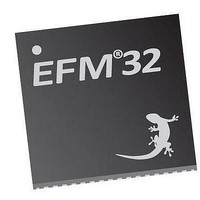EFM32TG210F32 Energy Micro, EFM32TG210F32 Datasheet - Page 303

EFM32TG210F32
Manufacturer Part Number
EFM32TG210F32
Description
MCU 32BIT 32KB FLASH 32-QFN
Manufacturer
Energy Micro
Series
Tiny Geckor
Specifications of EFM32TG210F32
Core Processor
ARM® Cortex-M3™
Core Size
32-Bit
Speed
32MHz
Connectivity
EBI/EMI, I²C, IrDA, SmartCard, SPI, UART/USART
Peripherals
Brown-out Detect/Reset, DMA, POR, PWM, WDT
Number Of I /o
24
Program Memory Size
32KB (32K x 8)
Program Memory Type
FLASH
Ram Size
4K x 8
Voltage - Supply (vcc/vdd)
1.8 V ~ 3.8 V
Data Converters
A/D 4x12b, D/A 1x12b
Oscillator Type
External
Operating Temperature
-40°C ~ 85°C
Package / Case
32-VQFN Exposed Pad
Processor Series
EFM32
Core
ARM Cortex-M3
Data Bus Width
32 bit
Data Ram Size
32 KB
Interface Type
UART, I2C, SPI
Maximum Clock Frequency
32 MHz
Number Of Programmable I/os
17
Number Of Timers
1
Operating Supply Voltage
1.8 V to 3.8 V
Maximum Operating Temperature
+ 85 C
Mounting Style
SMD/SMT
Processor To Be Evaluated
EFM32TG210
Lead Free Status / RoHS Status
Lead free / RoHS Compliant
Eeprom Size
-
Lead Free Status / Rohs Status
Details
- Current page: 303 of 522
- Download datasheet (9Mb)
20.3.1 Pulse Counter Modes
20.3.1.1 Single Input Oversampling Mode
20.3.1.2 Externally Clocked Single Input Counter Mode
2010-12-21 - d0034_Rev0.90
Figure 20.1. PCNT Overview
The pulse counter can operate in single input oversampling mode (OVSSINGLE), externally clocked
single input counter mode (EXTCLKSINGLE) and externally clocked quadrature decoder mode
(EXTCLKQUAD). The following sections describe operation of each of the three modes and how they
are enabled. Input timing constraints are described in Section 20.3.5 (p. 306) and Section 20.3.6 (p.
306) .
This mode is enabled by writing OVSSINGLE (0x1) to the MODE field in the PCNTn_CTRL register and
disabled by writing DISABLE (0x0) to the same field. LFACLK is configured from the registers in the
Clock Management Unit (CMU), Chapter 11 (p. 94) .
The optional pulse width filter is enabled by setting to the FILT bit in the PCNTn_CTRL register.
Additionally, the PCNTn_S0IN input may be inverted, so that falling edges are counted, by setting to
the EDGE bit in the PCNTn_CTRL register.
If S1CDIR is cleared, PCNTn_S0IN is the only observed input in this mode. The PCNTn_S0IN input
is sampled by the LFACLK and the number of detected positive or negative edges on PCNTn_S0IN
appears in PCNTn_CNT. The counter may be configured to count down by setting to the CNTDIR bit
in PCNTn_CTRL. Default is to count up.
The counting direction can also be controlled externally in this mode by setting S1CDIR in PCNTn_CTRL.
This will make the input value on PCNTn_S1IN decide the direction counted on a PCNTn_S0IN edge.
If PCNTn_S1IN is high, the count is done according to CNTDIR in PCNTn_CTRL. If low, the count
direction is opposite.
This mode is enabled by writing EXTCLKSINGLE (0x2) to the MODE field in the PCNTn_CTRL register
and disabled by writing DISABLE (0x0) to the same field. The external pin clock source must be
configured from the registers in the CMU (Chapter 11 (p. 94) ).
Positive edges on PCNTn_S0IN are used to clock the counter. Similar to the oversampled mode,
PCNTn_S1IN is used to determine the count direction if S1CDIR in PCNTn_CTRL is set. If not, CNTDIR
in PCNTn_CTRL solely defines count direction. As the LFACLK is not used in this mode, the PCNT
module can operate in EM3.
S1PRS Input
S0PRS Input
CMU (conseptual)
Inverter
Inverter
LFACLK
Clock
switch
Pulse Width
Quadrature
decoder
Filter
...the world's most energy friendly microcontrollers
303
detector
Edge
EXTCLK_SINGLE
EXTCLK_QUAD
OVR_SINGLE
1
CNT
www.energymicro.com
TOP
Peripheral bus
TOPB
Related parts for EFM32TG210F32
Image
Part Number
Description
Manufacturer
Datasheet
Request
R

Part Number:
Description:
KIT STARTER EFM32 GECKO
Manufacturer:
Energy Micro
Datasheet:

Part Number:
Description:
KIT DEV EFM32 GECKO LCD SUPPORT
Manufacturer:
Energy Micro
Datasheet:

Part Number:
Description:
BOARD PROTOTYPING FOR EFM32
Manufacturer:
Energy Micro
Datasheet:

Part Number:
Description:
KIT DEVELOPMENT EFM32 GECKO
Manufacturer:
Energy Micro
Datasheet:

Part Number:
Description:
MCU, MPU & DSP Development Tools TG840 Sample Kit
Manufacturer:
Energy Micro
Datasheet:

Part Number:
Description:
MCU, MPU & DSP Development Tools TG Starter Kit
Manufacturer:
Energy Micro
Datasheet:

Part Number:
Description:
MCU, MPU & DSP Development Tools TG108 Sample Kit
Manufacturer:
Energy Micro

Part Number:
Description:
MCU, MPU & DSP Development Tools TG210 Sample Kit
Manufacturer:
Energy Micro
Datasheet:

Part Number:
Description:
MCU, MPU & DSP Development Tools TG822 Sample Kit
Manufacturer:
Energy Micro
Datasheet:

Part Number:
Description:
MCU, MPU & DSP Development Tools TG230 Sample Kit
Manufacturer:
Energy Micro

Part Number:
Description:
SAMPLE KIT (SMALL BOX - CONTAINING 2 DEVICES)
Manufacturer:
Energy Micro

Part Number:
Description:
SAMPLE KIT (SMALL BOX - CONTAINING 2 DEVICES)
Manufacturer:
Energy Micro










